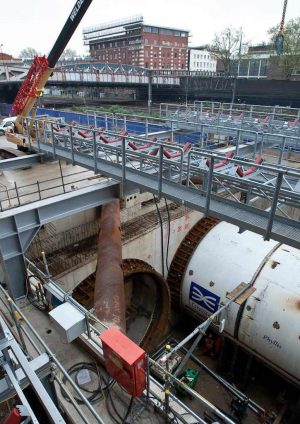
Crossrail Tunnel Boring Machine launch and reception arrangements
Document
type: Micro-report
Author:
John Davis EurGeol CGeol MSc DIC
Publication
Date: 31/10/2016
-
Abstract
This report sets out the geological conditions at each Crossrail TBM launch or reception location and summarises any ground treatment and/or dewatering requirements that were applied as a result.
-
Read the full document
Crossrail TBM launch and reception arrangements
For the Crossrail TBMs the following table summarises:
- The relevant geology.
- Whether any dewatering or depressurisation was required for TBM launch or reception.
Contract C300 constructed running tunnels between:
- Royal Oak Portal and Farringdon Station (Drive X)
Contract C305 constructed running tunnels between:
- Limmo Shaft and Farringdon (Drive Y)
- Pudding Mill Lane Portal and Stepney Green Shaft (Drive Z)
- Limmo Shaft and Victoria Dock Portal (Drive G)
Contract C310 constructed running tunnels between:
- Plumstead Portal and North Woolwich Portal (Drive H)
Location Launch Conditions Reception Conditions Drive X Royal Oak Portal The TBM launched into a full face of London Clay and there were no specific ground improvement or dewatering requirements. N/A Drive X Paddington Station N/A. The TBMs passed through the London Clay in the Station Box area before it was excavated. Drive X Bond Street Station N/A The TBMs passed through the station when only the ticket hall box walls were in place and before any excavation had taken place. Drive X Tottenham Court Road Station N/A The TBMs passed through the station when only the ticket hall box walls were in place and before any excavation had taken place. Fisher Street SCL crossover cavern N/A The TBMs passed through this area prior to construction of the Crossover. Drive X Farringdon Station N/A The Farringdon area is faulted and at platform tunnel level the strata varies between the London Clay and the upper parts of the Lambeth Group.
The eastbound TBM shield was buried off alignment towards the east end of the Station prior to completion of the Station box structures and so did not pass through any box or shaft walls. The WB TBM passed through shaft walls and foam concrete backfill in the base of the western ticket hall. This shield was also buried off alignment towards the east end of the Station.
Prior to burial both TBMs passed through short SCL tunnels backfilled with foam concrete constructed within the platform tunnel alignments.
Drives Y and G at Limmo Shaft There were no ground improvement or dewatering requirements specifically for the TBM launches. The TBM launches were in to a full face of London Clay N/A Drive G Victoria Dock Portal
N/A Tunnel face ground conditions at the portal headwall = Alluvium over River Terrace Deposits over London Clay.
The Alluvium was soil mixed over the last 50m of the tunnel drives.
The River Terrace Deposits was permeation grouted over the last 200m of the tunnel drives.
A 200m long micropile ‘volume loss cut off wall’ was provided between the tunnels and the adjacent DLR.
A support ‘umbrella‘ of TaM pipes and micropiles was provided under an adjacent and important gas main.
Drive Y Canary Wharf Station
The tunnel face ground conditions at the station box headwall were Lambeth Group clays with sandy HF just above the crown.
The Canary Wharf Group deep aquifer dewatering system was operating during TBM launch.
The tunnel face ground conditions at the station box headwall were Lambeth Group clays with sandy Harwich Formation just above the crown.
The Canary Wharf Group deep aquifer dewatering system was operating during TBM reception.
A grouted pipe canopy was provided above the crown and shoulder of the tunnel at both reception locations.
Visible settlement was noted within the Station box cofferdam above the reception locations after reception despite the presence of the grouted pipe canopy.
Drive Y and Z EB receptions at Stepney Green Shaft N/A EB only Full face London Clay at reception. No ground treatment required, but the depressurisation of Lambeth Group sand channels was in place for other reasons. Drive Y and Z WB receptions at Stepney Green Shaft
N/A WB only Lambeth Group sand channels in and below the invert at Reception. These sand channels were depressurised by a combination of surface and wells constructed in the SCL reception chambers. Drive Y Launch at Stepney Green Shaft
No ground improvement or dewatering requirements for the launches (though the Lambeth Group sand channel depressurisation was active for other reasons). N/A Drive Y Whitechapel Station
The launches were assisted by a depressurisation system in the underlying Lambeth Group sand channels that was in place for the construction of SCL crossover tunnels immediately west of Whitechapel Station. No ground treatment required Drive Y Liverpool St. Station
No specific ground improvement or dewatering requirements for the TBM launches. The TBM launches were in to a full face of LC and LG clay.
In tunnel depressurisation of Lambeth Group sand channels below the invert was provided from both the EB and WB SCL reception chambers. This depressurisation was assisted by the concurrent operation of depressurisation below the base of the adjacent Crossrail Blomfield Box. Drive Y Farringdon Station
N/A Both EB and WB TBM had LG sand channels within the face close to the headwalls of the SCL reception chambers at the east end of Farringdon Station. These sand channels were depressurised using wells installed from the surface. Drive Z Pudding Mill Lane Portal
The strata present in and above the tunnel face outside the portal headwall were Alluvium over River Terrace Deposits over London Clay over Harwich Formation and a Lambeth Group Sand Channel.
The tunnels both passed just below a sensitive 400KV power cable shortly after launch.
The shallow cover and therefore the limited ability to apply TBM face pressure required the permeable water bearing River Terrace Deposits to be permeation grouted and the underlying Harwich Formation and Sand Channel strata to be depressurised via surface wells.
N/A Drive Z Eleanor Street Shaft and Mile End Shaft The SCL tunnels that connect the running tunnels to the shafts were constructed before passage of the TBMs. These connection tunnels were temporarily backfilled with foam concrete prior to TBM passage. Drive H Plumstead Portal The launch ground conditions were water bearing River Terrace Deposits and Thanet Sands. The launch was through a grout bag type portal headwall seal. N/A Drive H Woolwich Station The launch ground conditions were water bearing Thanet Sands. The launch was through a grout bag type box headwall seal. The reception ground conditions were water bearing Thanet Sands. TBM reception involved mining into a (patented) pressurised chamber containing a seal. This chamber was connected to the Station box headwall. Drive H North Woolwich Portal N/A The reception ground conditions were water bearing Thanet Sands. TBM reception involved mining into a (patented) pressurised chamber containing a seal. This chamber was connected to the Station box headwall. -
Authors
John Davis EurGeol CGeol MSc DIC - Geotechnical Consulting Group
John was seconded to the Chief Engineers Group within Crossrail from Geotechnical Consulting Group LLP from 2009 until July 2016.
Within the Chief Engineers Group John was responsible for all Crossrail geotechnical matters east of Farringdon. Whilst at Crossrail John was also closely involved with the production of Geotechnical Baseline Reports for all the major Civils contracts. Prior to Crossrail John spent 20+ years as a geotechnical designer working on a diverse range of structures across the world, these included deep basements, embankments, tunnels, slopes and retaining walls. John was seconded to London Underground for a couple of years in the mid 90’s where he led a research programme on the impact of rising groundwater on the tube network.
